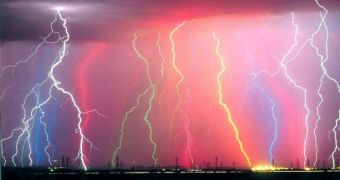Lightning is an atmospheric phenomenon that even today remains mostly mysterious to the researchers. On top of having enough difficulties explaining why lightning forms in the fist place, scientists have also been struggling for decades to understand why bolts of lightning forming in the top layers of the clouds travel all the way through it, to escape and discharge outside it. Simply put, according to computer simulations, lightnings cannot form in Earth's atmosphere. The electric field generated by the friction between the masses of air is not large enough to generate an electric disruptive discharge.
Nonetheless, lightnings occur on Earth every day. But let's leave this aside for now and return to the second part of the problem. Researchers claim to have finally created a model that explains how electric discharges forming in a particular cloud escape and generate a so-called 'bolt from the blue'. Cloud-to-ground lightning penetrates the cloud all the way from top to bottom, to hit a spot on the surface several kilometers away from the storm.
It has been long known that lightning takes shape between the positively and negatively charged layers of a cloud, albeit scientists could not explain what determines it to escape. "According to those theories, all lightning should remain trapped between the charged layers, inside clouds. We had suspicions about why it would go towards the ground, but we had no idea why it would go upwards," said Jeremy Riousset of Penn State University.
Charge distribution
The new model reveals that the necessary conditions to determine such a discharge could be met when the positive and negative layers inside a cloud are redistributed, thus amplifying the difference in potential allowing it to escape. Additionally, the distribution pattern also affects the direction of the discharge, making it go either upwards or downwards. Strangely, most of the discharges move in a upward direction rather than downwards, as common sense makes us believe.
Furthermore, the original path of the lightning discharge has no relevance for the final trajectory as the bolt of lightning may be re-directed. For example, an electrical discharge originally pointing in a upward direction could be re-routed towards the side of the cloud, to end-up hitting a target on the ground more than 40 kilometers away from were it originated.
"Lightning mapping shows that bolts-from-the-blue are surprisingly common," says Riousset.
Bolt from the blue
According to the new model developed at Penn State University there are at least three ways in which a bolt of lightning can be re-directed. One to the factors that influence the way such electric discharges behave is altitude.
Secondly, charge distribution inside the cloud and cloud-to-ground lightning usually determines further electrical discharges in a upward direction. With the model created by Riousset, lightning patterns can be predicted in relation to the type of cloud, whether it has an upward or downward direction, to hit targets on the ground tens of kilometers away from the storm, basically under a blue sky.

 14 DAY TRIAL //
14 DAY TRIAL //